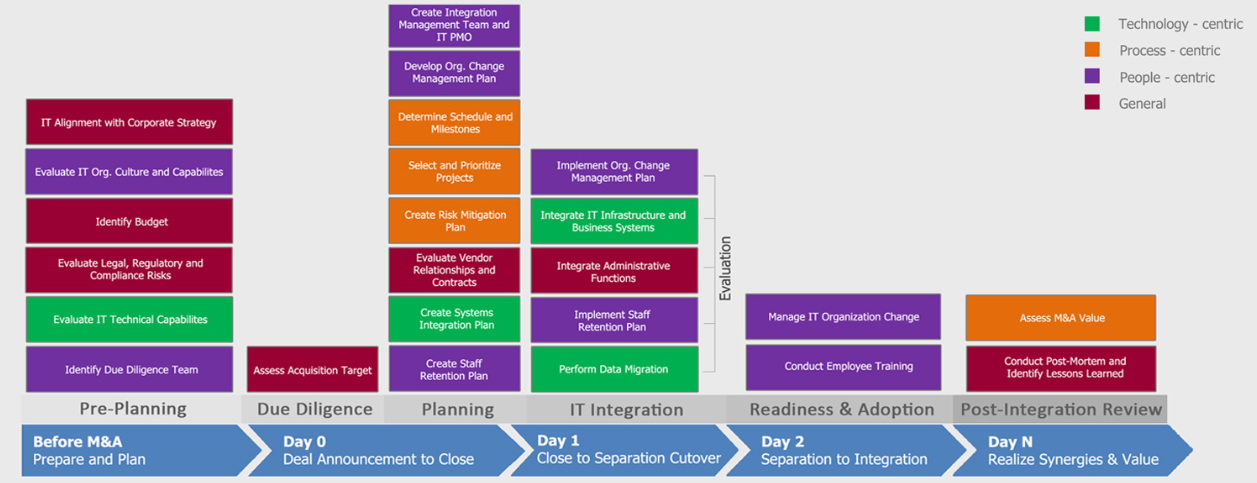A Mergers & Acquisitions Playbook for CIOs, Part 1
This is a guest post by David Spinelli, intellectual property (IP) development manager, and George Anderson, IP architect, Enterprise Strategy Services team within Microsoft’s Services organization. In part 1, they discuss the demand for a common playbook to prepare for and manage through M&A activities. In part 2, they discuss the elements of the M&A playbook for CIOs.
Business transactions, be it mergers, acquisitions, divestitures or joint ventures, are nothing more than actions of business strategies. The ultimate goals of M&A deals vary, but they’re typically intended to: increase stakeholder value through gaining market share; expand into new markets; acquire new products or skillsets; or optimize a component of the value chain. Depending on the size and complexity of these transactions, however, there can be significant disruptions to the overall organization and opportunities to lose focus by the CIO and the broader IT team.
The number of technology deals in the U.S. completed in the past couple of years continues to increase, thanks to sector convergence and constant innovations. In addition, cross-border acquisitions experienced a 78% increase in 2010 due to activity increase in Europe and Asia [source: PWC, Technology sectors converge. Deal activity rebounds. 2011 US technology M&A insights. March 2011. Print]. In fact, Asia was tops in 2011 as that region had the highest value of M&A deal in the asset management sector, while Japanese companies aggressively bought overseas counterparts in 2011 [here]. This form of cross-border transactions may likely increase as the global economy stabilizes and businesses seek to expand their market share beyond borders.
However, CIOs need to be aware that 50%-70% of all M&A transactions fail to create incremental stakeholder value. Although there are many reasons for this low rate of success, failed post-merger integration stands out as a common root cause of the failures [source: Peter Blatman, Mark Bussey, Jeff Benesch, The Role of Information Technology in Mergers and Acquisitions, Deloitte Consulting LLP, 2008]. Along those lines, CIOs and IT executives have identified common pitfalls in the M&A lifecycle:
- Failure to involve the CIO early enough in M&A planning and execution
- Inadequately addressing individual and organizational resistance to change
- Poor or incomplete due dilligence efforts
- Failure to plan for staff retention
- Failure to proactively mitigate culture clash within the IT organization and related organizations
- Not conducting, or ignoring, the risk assessment
- Not conducting just-in-time IT training before and after systems integration
The above findings come from an October 2011 survey of CIOs sponsored by Microsoft’s Services organization and conducted by a University of Arizona Eller College of Management MBA candidate team.
The survey report indicates that CIOs involved in M&A transactions need to be equipped to respond to strategic change events by facilitating the potential integration of IT capabilities across firms. To be successful, both structured guidelines and a framework to navigate IT integration complexities are needed. These findings are consistent with questions we receive from CIOs and other IT leaders involved in or preparing for M&A transactions:
- How do I assess what is strategic and what I can retire?
- How do I align the IT assets of both companies?
- Can you help me build my M&A playbook?
Introduction to the M&A Framework for IT
Clearly there are new trends and innovations in computer technology that affect the way IT integration is conducted going forward. Cloud computing, for instance, is creating a huge shift in computing technology and more businesses are moving to the cloud to house applications, data, and computing resources as industry sectors converge. The cloud phenomenon and the desire by technology companies to maximize markets are key drivers behind important industry changes.
However, CIOs will be well informed to acknowledge that technology represents only 33% of the activities across an M&A lifecycle. When organized through the lens of a framework, people-centric and process-centric activities outnumber technology-centric activities across the lifecycle of such business transactions. The people and processes need to be prepared. The technology aspects of M&A are always lagging efforts, and will need to be resolved beginning with Day 0.
The aforementioned survey conducted with the University of Arizona Eller College of Management led to the creation of an M&A framework (diagram below) and playbook for IT executives. The framework is designed to help IT executives navigate integration complexities throughout the M&A lifecycle. While you can apply this particular framework to nearly any M&A, it is most suited for consolidation, combination, and transformation projects that typically align with the 6 M&A phases (i.e., pre-planning, due diligence, planning, etc). The M&A playbook itself focuses on improving the processes prior to Day 0 of an M&A to Day 2 and beyond.
In part 2, we’ll discuss each of the 6 M&A phases, and how you can learn more about the playbook. If you’d like to learn more about this M&A Playbook, please send your inquiries and comments to
the Microsoft Enterprise Architecture IP team at enterprisestrategy@microsoft.com.
David Spinelli and George Anderson

